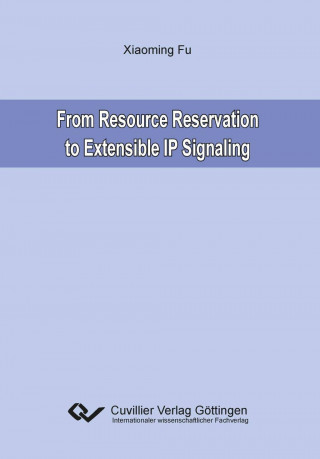
Code: 12828513
From Resource Reservation to Extensible IP Signaling
by Xiaoming Fu
In recent years, the tremendous growth of the Internet and the increasing demand of user applications have resulted in a number of architectural changes to the Internet infrastructure. By its original, the Internet based on the pa ... more
- Language:
 English
English - Binding: Paperback
- Number of pages: 172
Publisher: Cuvillier Verlag, 2014
- More about this

29.16 €
RRP: 32.31 €
You save 3.15 €

In stock at our supplier
Shipping in 6 - 8 days
You might also like
-

Fast Like a Girl
28.45 € -

You Can't Touch My Hair
13.52 € -21 % -

Comment Faire L'Amour Toute La Nuit
25.33 € -

Entwicklung Durch Handel?
48.74 € -

Française d'été, 1 ESO. Cuaderno de vacaciones
15.33 € -

Antiterrordateigesetz
85.58 € -

Myth and the Human Sciences
79.02 €
Give this book as a present today
- Order book and choose Gift Order.
- We will send you book gift voucher at once. You can give it out to anyone.
- Book will be send to donee, nothing more to care about.
More about From Resource Reservation to Extensible IP Signaling
You get 73 loyalty points
 Book synopsis
Book synopsis
In recent years, the tremendous growth of the Internet and the increasing demand of user applications have resulted in a number of architectural changes to the Internet infrastructure. By its original, the Internet based on the packet-switched technology has been designed for delivering packets in a best effort fashion: the end systems do not need to inform the network prior to transmitting their IP packets, whole routers simply perform routing and forwarding of these packets without distinguishing from each other. However, this design has been challenged due to the new requirements which have been dramatically different from over 30 years ago. For example, to realize the bandwidth and connectivity on demand for the service providers, a signaling protocol seems to be critical. Signaling is not a new topic. In the telecommunication industry, signaling is common and can be dated back to when circuit switches first replaced human telephone operators. Even the modern Signaling System No. 7 (SS7) [187] began its development in the mid 1970's, based on the idea that relies on a separate control element (i.e., the SS6 signal switches) to signal to other control element to set up, manage and release voice trunk lines required to make a call. Based on the signaling standard for ISDN [8], ITU-T standardized a Q.2931 signaling protocol [9] which allows ATM nodes to exchange control of information, request the use of network resources, or negotiate for the use of circuit parameters, for instance, mapping between an input set and an output set of virtual circuit parameters, for instance, mapping between an input set and an output set of virtual circuit identifiers (VCIs) and virtual path identifiers (VPIs). Essentially, signaling protocols manages states in network nodes. They generally reflect some requirements of an end-to-end session/call to the traverses nodes. Thus, they need to be maintained properly, especially when network "conditions" change (e.g., some link or node fails, or the traversing route changes). The task of a signaling protocol involves establishing, maintaining and removing network control states, traversing from one end system to another through the network. Hence, the concept of signaling protocol discussed in this book mainly targets at network control state singnaling.
 Book details
Book details
29.16 €
- Full title: From Resource Reservation to Extensible IP Signaling
- Author: Xiaoming Fu
- Language:
 English
English - Binding: Paperback
- Number of pages: 172
- EAN: 9783954046010
- ISBN: 3954046016
- ID: 12828513
- Publisher: Cuvillier Verlag
- Weight: 231 g
- Dimensions: 210 × 148 × 9 mm
- Date of publishing: 07. March 2014
Trending among others
-

The Book of Bill
23.81 € -14 % -

Gravity Falls Journal 3
16.44 € -23 % -

Berserk Deluxe Volume 1
44.40 € -11 % -

Pumpkin Spice Cafe
11.70 € -18 % -

Berserk Deluxe Volume 2
52.28 € -

White Nights
3.52 € -23 % -

It ends with us
8.97 € -30 % -

48 Laws Of Power
18.06 € -29 % -

A Little Life
17.55 € -

Atomic Habits
15.94 € -14 % -

Gilmore Girls: The Official Advent Calendar
28.96 € -25 % -

Berserk Deluxe Volume 3
48.84 € -3 % -

The 48 Laws of Power
24.62 € -5 % -

Jujutsu Kaisen, Vol. 23
11.09 € -15 % -

Surrounded by Idiots
10.49 € -29 % -

The Official Stardew Valley Cookbook
22.40 € -19 % -

Berserk Deluxe Volume 4
45.31 € -10 % -

Iron Flame
16.24 € -18 % -

A Good Girl's Guide to Murder
8.17 € -14 % -

A Curse For True Love
10.39 € -12 % -

Berserk Deluxe Volume 5
50.56 € -

It Starts with Us
8.97 € -16 % -

Twisted Love
9.78 € -24 % -

Powerless
10.49 € -18 % -

The Husky and His White Cat Shizun: Erha He Ta de Bai Mao Shizun (Novel) Vol. 6
16.24 € -19 % -

English File: Intermediate: Student's Book with Online Practice
25.63 € -7 % -

Twisted Hate
10.18 € -20 % -

Court of Mist and Fury
9.38 € -18 % -

Twisted Lies
9.78 € -24 % -

Chainsaw Man, Vol. 16
11.29 € -13 % -

Psychology of Money
18.87 € -4 % -

Berserk Deluxe Volume 6
51.27 € -

Reckless
10.29 € -20 % -

Gravity Falls: Lost Legends
17.75 € -15 % -

Twisted Games
9.78 € -17 % -

English File Upper Intermediate Student's Book with Student Resource Centre Pack (4th)
36.43 € -6 % -

Court of Thorns and Roses Paperback Box Set (5 books)
50.05 € -20 % -

Everything I Know About Love
10.39 € -29 % -

Headway: Elementary: Student's Book with Online Practice
25.02 € -7 % -

Court of Thorns and Roses
9.28 € -19 % -

Vagabond (VIZBIG Edition), Vol. 1
24.62 € -

Meow
20.78 € -

Headway: Elementary: Workbook Without Key
14.02 € -

Once Upon A Broken Heart
9.88 € -23 % -

A Court of Wings and Ruin
10.79 € -6 % -

SOLO LEVELING V09
17.75 € -15 % -

The Ballad of Never After
10.18 € -20 % -

The Courage To Be Disliked
10.99 € -27 % -

A Court of Silver Flames
10.18 € -20 %
Collection points Bratislava a 2642 dalších
Copyright ©2008-24 najlacnejsie-knihy.sk All rights reservedPrivacyCookies


 15549 collection points
15549 collection points Delivery 2.99 €
Delivery 2.99 € 02/210 210 99 (8-15.30h)
02/210 210 99 (8-15.30h)